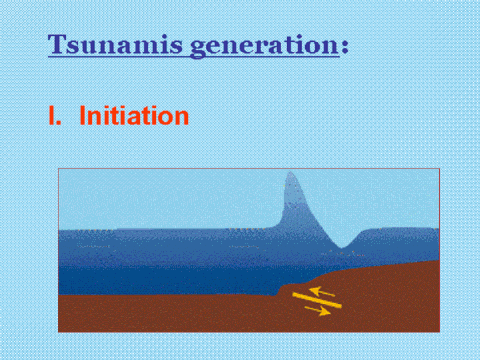| front |1 |2 |3 |4 |5 |6 |7 |8 |9 |10 |11 |12 |13 |14 |15 |16 |17 |18 |19 |20 |21 |22 |23 |24 |25 |26 |27 |28 |29 |30 |31 |32 |33 |34 |35 |36 |37 |38 |39 |40 |41 |42 |43 |44 |45 |46 |47 |48 |review |
 |
"I. Initiation:
Earthquakes are commonly associated with ground shaking that is a result of
elastic waves traveling through the solid earth. However, near the source of
submarine earthquakes, the seafloor is "permanently" uplifted and
down-dropped, pushing the entire water column up and down. The potential
energy that results from pushing water above mean sea level is then
transferred to horizontal propagation of the tsunami wave (kinetic energy).
For the case shown in the slide, the earthquake rupture occurred at the base
of the continental slope in relatively deep water. Situations can also arise
where the earthquake rupture occurs beneath the continental shelf in much
shallower water. Note: In the figure the waves are greatly exaggerated compared to water depth! In the open ocean, the waves are at most, several meters high spread over many tens to hundreds of kilometers in length." Citation source: http://www.owlnet.rice.edu/~esci108/108_EQ_Lec_4.ppt |